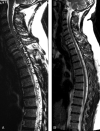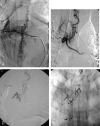Double spinal dural arteriovenous fistulas
- PMID: 16484401
- PMCID: PMC8148813
Double spinal dural arteriovenous fistulas
Abstract
We present a patient with double spinal dural arteriovenous fistulas revealed by progressive myelopathy. Numerous dilated veins extending along the entire length of the spinal cord were found on MR imaging. Angiography showed a first spinal dural fistula at the level of T7 with descending venous drainage and a second spinal dural fistula at the level of T5 with ascending venous drainage. Both fistulas were cured by therapeutic embolization.
Figures



Similar articles
-
Intracranial dural arteriovenous fistula with spinal medullary venous drainage.Eur Radiol. 2000;10(10):1606-9. doi: 10.1007/s003300000382. Eur Radiol. 2000. PMID: 11044933
-
Endovascular treatment for dural arteriovenous fistula of the anterior condylar vein with unusual venous drainage: report of two cases.AJNR Am J Neuroradiol. 2005 Sep;26(8):1955-9. AJNR Am J Neuroradiol. 2005. PMID: 16155141 Free PMC article.
-
Spinal vascular malformations: MR angiography after treatment.Radiology. 2001 May;219(2):346-53. doi: 10.1148/radiology.219.2.r01ap26346. Radiology. 2001. PMID: 11323455
-
Multiple spinal arteriovenous fistulas: A case-based review.Clin Neurol Neurosurg. 2015 Dec;139:6-11. doi: 10.1016/j.clineuro.2015.08.033. Epub 2015 Sep 2. Clin Neurol Neurosurg. 2015. PMID: 26355909 Review.
-
[Spinal dural arteriovenous fistulas : Diagnostics and therapy].Radiologe. 2012 May;52(5):437-41. doi: 10.1007/s00117-011-2293-9. Radiologe. 2012. PMID: 22584480 Review. German.
Cited by
-
Double spinal dural arteriovenous fistula with multiple draining veins: A case report.Medicine (Baltimore). 2025 Aug 8;104(32):e43853. doi: 10.1097/MD.0000000000043853. Medicine (Baltimore). 2025. PMID: 40797448 Free PMC article.
References
-
- Merland JJ, Riche MC, Chiras J. Intraspinal extramedullary AV fistulae draining into the medullary veins. J Neuroradiology 1980;7:271–320 - PubMed
-
- Rosenblum B, Oldfield E, Doppman J, et al. Spinal arteriovenous malformations: a comparison of dural arteriovenous fistulae and intradural AVMs in 81 patients. J Neurosurg 1987;67:795–803 - PubMed
-
- Oldfield E, Doppman J. Spinal arteriovenous malformations. Clin Neurosurg 1988;34:161–68 - PubMed
-
- Symon L, Kuyama H, Kendall B. Dural arteriovenous malformations of the spine: clinical features and surgical results in 55 cases. J Neurosurg 1984;60:238–47 - PubMed
-
- Thron A. Spinal dural arteriovenous fistulas. Radiology 2001;41:955–60 - PubMed
Publication types
MeSH terms
LinkOut - more resources
Full Text Sources
Medical
